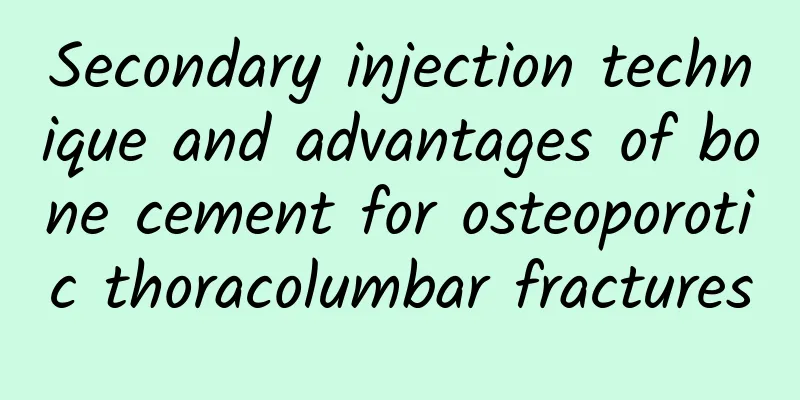Secondary injection technique and advantages of bone cement for osteoporotic thoracolumbar fractures

|
Osteoporosis is a common disease among the elderly. With the increase of age, the functions of the elderly are gradually declining. It is characterized by low bone mass, damaged bone tissue microstructure, brittle bones, and easy fractures. Fractures are prone to occur in the thoracic and lumbar vertebrae. In the past, patients with such thoracolumbar fractures usually took conservative treatment and stayed in bed for three months. However, such long-term bed rest is accompanied by long-term bed rest complications such as bedsores, aspiration pneumonia, urinary tract infections, and lower extremity venous thrombosis, which increase the physical and mental pain of patients and seriously affect the quality of life of elderly patients. Fractures are not fatal, but complications are fatal. Minimally invasive percutaneous vertebroplasty is currently an effective treatment for osteoporotic vertebral compression fractures. This technology allows patients to get up and move on the second day after surgery, effectively reducing the occurrence of complications of thoracolumbar fractures and significantly improving the quality of life of patients. Vertebroplasty has become the preferred method for treating thoracolumbar fractures. However, during the operation, there is a risk of bone cement leakage, with an incidence of 5%-80% [1]. Bone cement leakage in important parts such as blood vessels and spinal canals can cause catastrophic consequences such as death from pulmonary embolism and paralysis of the lower limbs, causing serious secondary injuries to patients. Leakage occurs mostly because the fracture line affects the edge of the vertebral body, causing bone cement to flow out along the fracture gap. To avoid the risk of bone cement leakage during surgery, the Department of Orthopedics of our hospital uses a double-injection technique of bone cement[2]: Based on the fracture cracks of the anterior wall or upper and lower end plates of the vertebral body located by preoperative 3D CT, the puncture tip is placed near the rupture during the operation. The bone cement is mixed for the first time, and after forming a high-viscosity "dough stage", "targeted occlusion" of the rupture is performed. Five minutes after the occlusion, the bone cement is mixed for the second time, and the low-viscosity "drawing stage" of bone cement is pushed to fill the fractured vertebra. The drawing stage bone cement has good mass properties, which is conducive to filling the entire vertebral body, restoring height, improving the stable support function, and effectively relieving the patient's pain. Figure 1: The first mixing of bone cement during the operation to perform "targeted closure" of the rupture Figure 2: Second preparation of bone cement during surgery, low-viscosity "drawing phase" bone cement was pushed to fill the fractured vertebra Figure 3: Postoperative review of the lumbar spine AP and lateral radiographs: The height of the L3 fractured vertebra was restored and there was no leakage of bone cement. The secondary push injection of bone cement can effectively reduce the occurrence of bone cement leakage during surgery, improve surgical safety, provide stable support, effectively relieve patient pain, and improve patient quality of life. Author: Qiu Shuiqiang Setting: Shanghai Hongkou District Jiangwan Hospital, Shanghai Health Medical College Affiliated Hospital Orthopedics Department References: [1] Li Qingda. Several issues on bone cement leakage after vertebral augmentation surgery for osteoporotic thoracolumbar fractures[J]. Chinese Journal of Traumatology, 2022, 38(3): 43. [2] Liu Chengzhou, Jia Baoxin, Gao Xiaoqiang. Clinical application of targeted bone cement filling and secondary injection technology in vertebroplasty[J]. Chinese Journal of Orthopaedics and Traumatology, 2023, 36(1): 38-40. |
<<: If you stick to these 5 "good habits", your health may get worse!
Recommend
Can I eat grapes when I have my period?
Grapes are a very common fruit in our lives. Grap...
How much pelvic fluid is normal?
Gynecological diseases have a great impact on man...
Dentures need regular maintenance to keep your smile
Author: Wang Ran, Zhang Lan, Liu Yuqi, Zheng Jiqi...
New research finds: Eating more dark chocolate can reduce the risk of diabetes? The truth is...
Chocolate is delicious and loved by people, but a...
What should girls do if their feet smell in summer?
Just imagine how embarrassing it would be if a gi...
What will happen if the vehicle's gasoline filter is clogged? Can the built-in gasoline filter be washed?
Every car has a gasoline filter, which plays a fi...
Can I wash my feet during confinement after a normal birth?
Pregnant women have weak systems after giving bir...
What are the symptoms of pelvic inflammatory disease?
Pelvic inflammatory disease is a common disease a...
Labelled as "designed for babies", but using fake salmon? Here are 26 types of fish tested!
So infuriating! Some time ago, we tested a wave o...
What is the cause of high alkaline phosphatase in pregnant women?
Alkaline phosphatase is mainly distributed in som...
What medicine should I take if ovulation is not good?
Ovulation is very important for women. On the one...
Itchy lower body and burning sensation when urinating
Gynecological inflammation, in simple terms, is a...
Does cervicitis affect the fetus?
Cervicitis is a relatively common gynecological d...
Are you pregnant if you keep urinating?
For women, if they always want to urinate, it mea...









